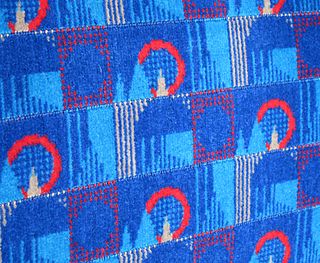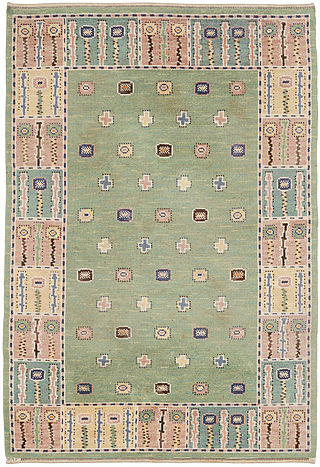
Ice skates are metal blades attached underfoot and used to propel the bearer across a sheet of ice while ice skating.

A rug is a piece of cloth, similar to a carpet, but it does not span the width of a room and is not attached to the floor. It is generally used as a floor covering, or as a decorative feature.
Flooring is the general term for a permanent covering of a floor, or for the work of installing such a floor covering. Floor covering is a term to generically describe any finish material applied over a floor structure to provide a walking surface. Both terms are used interchangeably but floor covering refers more to loose-laid materials.

A chair is a type of seat, typically designed for one person and consisting of one or more legs, a flat or slightly angled seat and a back-rest. It may be made of wood, metal, or synthetic materials, and may be padded or upholstered in various colors and fabrics.

A carpet is a textile floor covering typically consisting of an upper layer of pile attached to a backing. The pile was traditionally made from wool, but since the 20th century synthetic fibers such as polypropylene, nylon, or polyester have often been used, as these fibers are less expensive than wool. The pile usually consists of twisted tufts that are typically heat-treated to maintain their structure. The term carpet is often used in a similar context to the term rug, but rugs are typically considered to be smaller than a room and not attached to the floor.

Jute is a long, rough, shiny bast fibre that can be spun into coarse, strong threads. It is produced from flowering plants in the genus Corchorus, of the mallow family Malvaceae. The primary source of the fiber is Corchorus olitorius, but such fiber is considered inferior to that derived from Corchorus capsularis.

A mat is a hard floor covering that generally is placed on a floor or other flat surface. Mats serve a range of purposes including:

Upholstery is the work of providing furniture, especially seats, with padding, springs, webbing, and fabric or leather covers. The word also refers to the materials used to upholster something.

A Persian carpet or Persian rug, also known as Iranian carpet, is a heavy textile made for a wide variety of utilitarian and symbolic purposes and produced in Iran, for home use, local sale, and export. Carpet weaving is an essential part of Persian culture and Iranian art. Within the group of Oriental rugs produced by the countries of the "rug belt", the Persian carpet stands out by the variety and elaborateness of its manifold designs.

A scratching post is a wooden post covered in rough material that cat owners provide so their pets have an acceptable place to scratch. The most common type consists of a wooden post, roughly 60–90 cm tall, covered in rough fabric or sisal. The post is mounted vertically in a wide base, which allows the cat to stretch upward on its rear legs and scratch freely without tipping it over. A post that is unstable or does not allow a cat to fully extend its body might put off the cat from using it. Surfaces vary: the post may be covered in sisal rope, upholstery fabric, the jute backing of a piece of carpet, or sections of corrugated cardboard. Many pet owners say they have to experiment with different surfaces to find one that their cats will scratch reliably. Matt Wildman, a cat behaviorist, explained that sisal or corrugated cardboard surfaces are favored by most cats. Other kinds of scratching posts are more elaborate, with several levels of horizontal platforms for climbing and cozy cave-like areas where cats may hide. Very tall ones are often called "cat trees." These may have a vertical tension rod that extends to the ceiling to provide extra stability.

Ethylene-vinyl acetate (EVA), also known as poly(ethylene-vinyl acetate) (PEVA), is a copolymer of ethylene and vinyl acetate. The weight percent of vinyl acetate usually varies from 10 to 50%, with the remainder being ethylene. There are three different types of EVA copolymer, which differ in the vinyl acetate (VA) content and the way the materials are used.

A stiletto heel, or just stiletto, is a shoe with a long, thin, high heel. It is named after the stiletto dagger.

Moquette is a type of woven pile fabric in which cut or uncut threads form a short dense cut or loop pile. The pile's upright fibres form a flexible, durable, non-rigid surface with a distinctive velvet-like feel. Traditional moquette weave fabrics are made today from a wool nylon face with an interwoven cotton backing, and are ideally suited to applications such as public transport.

Carpet cleaning is performed to remove stains, dirt, and allergens from carpets. Common methods include hot water extraction, dry-cleaning, and vacuuming.

Tufting is a type of textile manufacturing in which a thread is inserted on a primary base. It is an ancient technique for making warm garments, especially mittens. After the knitting is done, short U-shaped loops of extra yarn are introduced through the fabric from the outside so that their ends point inwards.
The manufacture of textiles is one of the oldest of human technologies. To make textiles, the first requirement is a source of fiber from which a yarn can be made, primarily by spinning. The yarn is processed by knitting or weaving, which turns yarn into cloth. The machine used for weaving is the loom. For decoration, the process of colouring yarn or the finished material is dyeing. For more information of the various steps, see textile manufacturing.
Heat setting is a term used in the textile industry to describe a thermal process usually taking place in either a steam atmosphere or a dry heat environment. The effect of the process gives fibers, yarns or fabric dimensional stability and, very often, other desirable attributes like higher volume, wrinkle resistance or temperature resistance. Very often, heat setting is also used to improve attributes for subsequent processes.

Fitted carpet, also wall-to-wall carpet, is a carpet intended to cover a floor entirely. Carpet over 4 meters in length is usually installed with the use of a power-stretcher.

Vehicle mats, also known as "automobile floor mats", are designed to protect a vehicle's floor from dirt, wear, and salt corrosion.

Carpets and rugs have been handmade in Sweden for centuries, taking on many different forms and functions over the course of time. Rugs woven in the traditional Oriental manner, especially in the Ottoman Empire and points east, were originally brought to Sweden over trade routes as early as the early Middle Ages. In the centuries that followed, Swedish rug-makers often infused their works with themes and motifs traditionally found in Oriental rugs. Eventually, Swedish rug-makers would begin to use Oriental rug-making techniques, but themes and motifs more consistent with the artistic and cultural heritage of Sweden. By the early modern periods, rugs had long been an important avenue of art – especially folk art – in Swedish culture. By the beginning of the twentieth century, the craft was seen as being an important artistic and cultural practice throughout Sweden, and designers began to make rugs that had a broad international appeal. Swedish rugs from the mid-twentieth century remain among the most desirable and sought after in the rug world.
















